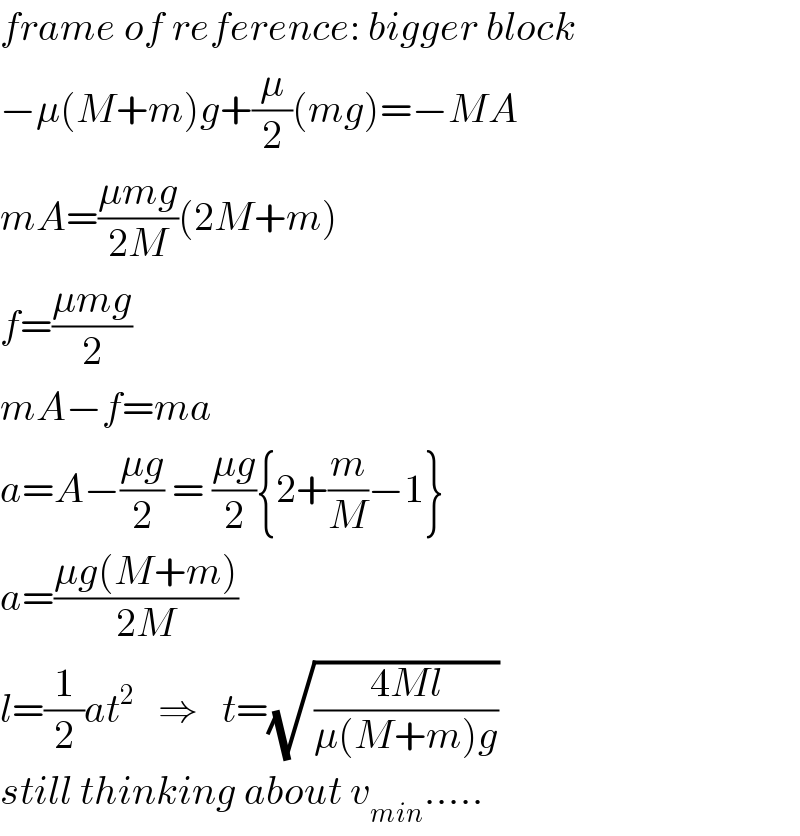
Question and Answers Forum
Question Number 99887 by mr W last updated on 23/Jun/20

Commented by mr W last updated on 23/Jun/20

Commented by Dwaipayan Shikari last updated on 23/Jun/20

Commented by Dwaipayan Shikari last updated on 23/Jun/20

Commented by Dwaipayan Shikari last updated on 23/Jun/20
Sir can you show your prove?
Commented by mr W last updated on 24/Jun/20

Answered by ajfour last updated on 24/Jun/20

Commented by ajfour last updated on 24/Jun/20

Answered by mr W last updated on 24/Jun/20
![a, u=acc. & velocity of mass m A, U=acc. & velocity of mass M ma=−(μ/2)mg ⇒a=−((μg)/2) u=v−((μg)/2)t≥0 MA=((μmg)/2)−μ(M+m)g ⇒A=−μg(1+(m/(2M))) U=v−μg(1+(m/(2M)))t≥0 Δa=a−A=((μg)/2)(1+(m/M)) L=(1/2)(Δa)t^2 ⇒t=(√((2L)/(Δa)))=2(√(L/(μg(1+(m/M))))) ...(i) (i) is valid only if U=v−(2+(m/M))(√((μgL)/(1+(m/M))))≥0 v≥v_2 =(2+(m/M))(√((μgL)/(1+(m/M)))) that means if v≥v_2 , the smaller block reaches the right end of the bigger block before the bigger block stops. if v<v_2 , the bigger blocks stops before the small block reaches the right end. assume the small block moves the distance L_1 on the big block at time t_1 as the bigger block stops. after this moment the bigger block rests on the the road and the small block moves the remaining distance L−L_1 . U_1 =v−(2+(m/M))(√((μgL_1 )/(1+(m/M))))=0 t_1 =2(√(L_1 /(μg(1+(m/M))))) ⇒L_1 =(((1+(m/M))v^2 )/(μg(2+(m/M))^2 )) ⇒t_1 =((2v)/(μg(2+(m/M)))) u_1 =v−((μg)/2)t_1 =v−(v/(2+(m/M)))=((1+(m/M))/(2+(m/M)))v starting with this velocity the smaller block should be able to move the remaining distance L−L_1 . (1/2)mu_1 ^2 ≥((μmg(L−L_1 ))/2) u_1 ^2 ≥μg(L−L_1 ) (((1+(m/M))/(2+(m/M))))^2 v^2 ≥μg[L−(((1+(m/M))v^2 )/(μg(2+(m/M))^2 ))] (((1+(m/M))^2 +1+(m/M))/((2+(m/M))^2 ))v^2 ≥μgL ((1+(m/M))/(2+(m/M)))v^2 ≥μgL ⇒v≥(√((1+(1/(1+(m/M))))μgL)) i.e. v_(min) =(√((1+(1/(1+(m/M))))μgL)) <v_2 summary: if 0<v< (√((1+(1/(1+(m/M))))μgL)) , small block can′t reach the right end, both blocks stoped moving before. if (√((1+(1/(1+(m/M))))μgL)) ≤v<(2+(m/M))(√((μgL)/(1+(m/M)))) small block reaches the right end, but the big block stoped moving before. if v≥(2+(m/M))(√((μgL)/(1+(m/M)))) small block reaches the right end and the big block is also in motion at this moment.](Q100014.png)
Commented by ajfour last updated on 24/Jun/20

